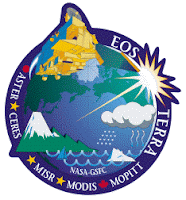NASA - EOS Terra Mission logo.
Oct. 5, 2016
Matthew (Atlantic Ocean)
Satellites from NASA and NOAA have been tracking and analyzing powerful Hurricane Matthew since its birth just east of the Leeward Islands on Sept. 28.
On October 4, 2016, Hurricane Matthew made landfall on southwestern Haiti as a category-4 storm—the strongest storm to hit the Caribbean nation in more than 50 years. Just hours after landfall, the Moderate Resolution Imaging Spectroradiometer (MODIS) on NASA’s Terra satellite acquired a natural-color image that showed the western extent over the eastern tip of Cuba and the eastern-most extent over Puerto Rico.
Image above: On October 4, 2016, Hurricane Matthew made landfall on southwestern Haiti as a category-4 storm—the strongest storm to hit the Caribbean nation in more than 50 years. Just hours after landfall, the Moderate Resolution Imaging Spectroradiometer (MODIS) on NASA’s Terra satellite acquired this natural-color image. At the time, Matthew had top sustained winds of about 230 kilometers (145 miles) per hour. Image Credits: NASA Earth Observatory image by Joshua Stevens.
At NASA's Goddard Space Flight Center in Greenbelt, Maryland the NASA/NOAA GOES Project combined infrared and visible imagery from NOAA's GOES-East satellite into an animation of Matthew. The animation of imagery from Oct. 3 to Oct. 5 shows Hurricane Matthew making landfall in Haiti and eastern Cuba then move toward the Bahamas.
On Oct. 5, there were many warnings and watches in effect on Oct. 5 from Cuba to the Bahamas to Florida.
A Hurricane Warning is in effect for the Cuban provinces of Guantanamo, Santiago de Cuba, Holguin, Granma and Las Tunas; the Southeastern Bahamas, including the Inaguas, Mayaguana, Acklins, Crooked Island, Long Cay, and Ragged Island; the Central Bahamas, including Long Island, Exuma, Rum Cay, San Salvador, and Cat Island; the Northwestern Bahamas, including the Abacos, Andros Island, Berry Islands, Bimini, Eleuthera, Grand Bahama Island, and New Providence. In Florida a Hurricane Warning is in effect from north of Golden Beach to the Flagler/Volusia county line and Lake Okeechobee.
A Hurricane Watch is in effect for the Cuban province of Camaguey and north of the Flagler/Volusia county line to Fernandina Beach. A Tropical Storm Warning is in effect for Haiti, Turks and Caicos Islands. In Florida a Hurricane Watch is in effect for Chokoloskee to Golden Beach, the Florida Keys from Seven Mile Bridge eastward, and Florida Bay.
At 11 a.m. EDT (1500 UTC), the eye of Hurricane Matthew was located near 21.8 degrees north latitude and 75.2 degrees west longitude. That's about 55 miles (90 km) north-northwest of Cabo Lucrecia, Cuba and about 105 miles (165 km) south of Long Island, Bahamas.
Satellite Animation Shows Hurricane Matthew Moving Toward Bahamas
Video above: This animation of NOAA's GOES-East satellite imagery from Oct. 3 to Oct. 5 shows Hurricane Matthew make landfall on Oct. 4 in western Haiti and move toward the Bahamas on Oct. 5. TRT: 00:38. Video Credits: NASA/NOAA GOES Project.
The National Hurricane Center (NHC) said "Matthew is moving toward the northwest near 12 mph (19 kph), and this motion is expected to continue during the next 24 to 48 hours. On this track, Matthew will be moving across the Bahamas through Thursday, and is expected to be very near the east coast of Florida by Thursday evening, Oct. 6.
Maximum sustained winds are near 120 mph (195 kph) with higher gusts. Matthew is a category 3 hurricane on the Saffir-Simpson Hurricane Wind Scale. Some strengthening is forecast during the next couple of days, and Matthew is expected to remain at category 3 or stronger while it moves through the Bahamas and approaches the east coast of Florida. Hurricane-force winds extend outward up to 45 miles (75 km) from the center and tropical-storm-force winds extend outward up to 175 miles (280 km)."
The minimum central pressure reported by both Hurricane Hunter planes was 962 millibars.
An unconfirmed wind gust of 155 mph (250 kph) was reported in Baracoa, Cuba, on the night of Oct. 4 as the eye of Matthew passed nearby.
For storm specifics on rainfall, wind and storm surge, visit the NHC website: http://www.nhc.noaa.gov.
NASA’s Terra satellite: http://www.nasa.gov/mission_pages/terra/index.html
NOAA's GOES-East satellite: http://www.ssd.noaa.gov/goes/east/
Image (mentioned), Video (mentioned), Text, Credits: NASA’s Goddard Space Flight Center/Rob Gutro.
Greetings, Orbiter.ch


